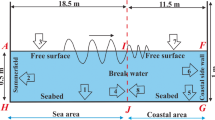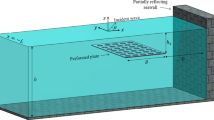Abstract
This study examines oblique wave interaction with a submerged perforated semicircular breakwater based on the linear potential theory. The fluid domain is divided into inner and outer regions by a perforated semicircular arc. The velocity potentials in the inner and outer regions are constructed by eigenfunction expansions and multipole expansions, respectively. The unknown constants in the velocity potentials are determined by matching the boundary conditions on the perforated arc. The convergence of the solution method we have developed is rapid. The reflection and transmission coefficients and the wave forces acting on the breakwater are calculated and examined. Some useful results are presented for practical engineering.








Similar content being viewed by others
References
Xie SL (1999) Waves forces on submerged semicircular breakwater and similar structures. China Ocean Eng 13(1):63–72
Naftzger RA, Chakrabarti SK (1979) Scattering of waves by two-dimensional circular obstacles in finite water depths. J Ship Res 23(1):32–42
Forbes LK, Schwartz LW (1982) Free-surface flow over a semicircular obstruction. J Fluid Mech 114:299–314
Forbes LK (1988) Critical free-surface flow over a semi-circular obstruction. J Eng Math 22:3–13
Cooker MJ, Peregrine DH, Vidal C, Dold JW (1990) The interaction between a solitary wave and a submerged semicircular cylinder. J Fluid Mech 215:1–22
Jia DH (1999) Study on the interaction of water waves with semi-circular breakwater. China Ocean Eng 13(1):73–80
Yuan DK, Tao JH (2003) Wave forces on submerged, alternately submerged, and emerged semicircular breakwaters. Coast Eng 48(2):75–93
Kasem T, Sasaki J (2010) Multiphase modeling of wave propagation over submerged obstacles using WENO and level set methods. Coast Eng J 52(3):235–259
Chapman GJD (2005) A weakly singular integral equation approach for water wave problems. PhD Thesis, University of Bristol, UK
Ursell F (1949) On the heaving motion of a circular cylinder on the surface of a fluid. Q J Mech Appl Math 2(2):218–231
Ursell F (1950) Surface waves on deep water in the presence of a submerged circular cylinder, II. Proc Camb Philos Soc 46:153–158
Thorne RC (1953) Multipole expansions in the theory of surface waves. Proc Camb Philos Soc 49(4):707–716
Ursell F (1968) The expansion of water-wave potentials at great distances. Proc Camb Philos Soc 64:811–826
Wu GX (1995) The interaction of water waves with a group of submerged spheres. Appl Ocean Res 17:165–184
Linton CM, McIver P (2001) Handbook of mathematical techniques for wave/structure interactions. Chapman & Hall/CRC, Boca Raton
Liu Y, Li HJ (2012) Analysis of wave interaction with submerged perforated semi-circular breakwaters through multipole method. Appl Ocean Res 34(1):164–172
Dhinakaran G, Sundar V, Sundaravadivelu R, Graw KU (2012) Performance of a perforated submerged semicircular breakwater due to non-breaking waves. Proc. IMechE M J Eng Marit Environ 226:36–50
Zhang NC, Wang LQ, Yu YX (2005) Oblique irregular waves load on semicircular breakwater. Coast Eng J 47(4):183–204
Yu XP (1995) Diffraction of water waves by porous breakwaters. J Waterway Port Coast Ocean Eng 121(6):275–282
Sollitt CK, Cross RH (1972) Wave transmission through permeable breakwaters. In: Proceedings of the 13th coastal engineering conference, Vancouver, pp 1827–1846
Li YC, Liu Y, Teng B (2006) Porous effect parameter of thin permeable plates. Coast Eng J 48(4):309–336
Tuck EO (1975) Matching problems involving flow through small holes. Adv Appl Mech 15:89–157
Chwang AT (1983) A porous-wavemaker theory. J Fluid Mech 132:395–406
Molin B (2011) Hydrodynamic modeling of perforated structures. Appl Ocean Res 33:1–11
Faltinsen OM, Firoozkoohi R, Timokha AN (2011) Analytical modeling of liquid sloshing in a two-dimensional rectangular tank with a slat screen. J Eng Math 70(1–3):93–109
Gradshteyn IS, Ryzhik IM (2007) Table of integrals, series, and products, 7th edn. Academic Press, New York
Wu GX (1991) On the second order wave reflection and transmission by a horizontal cylinder. Appl Ocean Res 13(2):58–62
Wu GX, Eatock Taylor R (1990) The second order diffraction force on a horizontal cylinder in finite water depth. Appl Ocean Res 12(3):106–11
Ursell F (1951) Trapping modes in the theory of surface waves. Proc Camb Philos Soc 47(2):347–358
Cho IH, Kim MH (2000) Interactions of horizontal porous flexible membrane with waves. J Waterway Port Coast Ocean Eng 126(5):245–253
Dalrymple RA, Losada MA, Martin PA (1991) Reflection and transmission from porous structures under oblique wave attack. J Fluid Mech 224:625–644
Liu Y, Li YC, Teng B, Jiang JJ, Ma BL (2008) Total horizontal and vertical forces of irregular waves on partially perforated caisson breakwaters. Coast Eng 55(6):537–552
Young DM, Testik FY (2009) Onshore scour characteristics around submerged vertical and semicircular breakwaters. Coast Eng 56(8):868–875
Evans DV, Jeffrey DC, Salter SH, Taylor JRM (1979) Submerged cylinder wave energy device: theory and experiment. Appl Ocean Res 1(1):3–12
Wu GX, Eatock Taylor R (1990) The hydrodynamic force on an oscillating ship with low forward speed. J Fluid Mech 211:333–353
Linton CM (2011) Water waves over arrays of horizontal cylinders: band gaps and Bragg resonance. J Fluid Mech 670:504–526
Acknowledgments
We wish to thank Prof. Guo-Xiong Wu at UCL for his valuable private notes on this work. We would like to thank the four reviewers and the associate editor Dr Andrew Hogg for their valuable comments, which greatly enhanced the quality of this paper. We also wish to thank Sarah Wood for proofreading this paper. This work was supported by the National Natural Science Foundation of China (Grants 51010009 and 50909086).
Author information
Authors and Affiliations
Corresponding author
Appendix: Multipoles with singularities on the water bottom for oblique wave
Appendix: Multipoles with singularities on the water bottom for oblique wave
Multipoles with singularities on the water bottom were given by Chapman [9]. Here the symmetric and antisymmetric multipoles, which have singularities at the semicircular breakwater centre \(r\) \(=\) 0 and satisfy Eqs. (3)–(6), are briefly introduced for the completeness of the presentation.
Solutions to Eqs. (3) and (4), which are singular at \(r\) \(=\) 0, can be written respectively as
where \(K_{n}\) is the modified Bessel function of the second kind of order \(n\). The preceding solutions can be represented as [15, Eqs. (B.101) and (B.103)]
where \(\nu =k_y \cosh \mu \).
The symmetric and antisymmetric multipoles, \(\varphi _n^+ \) and \(\varphi _n^- \), may have the following forms:
Obviously, Eqs. (33) and (34) satisfy the field equation in Eq. (3) and the water bottom condition in Eq. (4). The unknowns \(f^{+}(\mu )\) and \(f^{-}(\mu )\) can be determined using the free surface condition in Eq. (5). Then the symmetric and antisymmetric multipoles for the present problem can be written as
where the path of the integration passes below the pole at \(\mu =\kappa =\ln \left( {1/{\sin \beta }+\sqrt{1/{\sin ^{2}\beta }-1}} \right) \) to satisfy the radiation conditions in Eq. (6) [34, 35].
As \(x\rightarrow \pm \infty \), we have
where \(N_0^2 =\left[ {1+{\sinh \! \left( {2kh} \right) }/{\left( {2kh} \right) }} \right] /2\).
The multipoles can be written as power series expansions [29, Eq. A.4]:
where \(I_{m}\) is the modified Bessel function of the first kind of order \(m\) and
in which the path of the integration passes below the pole at \(\mu =\kappa \), and \(\varepsilon _0 =1\) and \(\varepsilon _m =2\) (\(m\ge 1)\).
Computational methods for such types of integrals in Eqs. (41) and (42) can be found in Linton [36, Eqs. (3.7) and (4.11)]. For example, the integral in Eq. (41) can be rewritten as
where PV denotes the principal value integral; the function \(S\left( {x,y} \right) \) is defined as \(S\left( {x,y} \right) =(K+x)\cosh \! \left( {2ny} \right) \cosh \left( {2my} \right) /{\left( {{\text{ e }}^{2xh}+1} \right) }\); the symbol \(b\) denotes the positive real root of the relationship
using the following integral:
in which \(\tilde{\nu }=\nu \;\tanh \! \left( {\nu h} \right) -k_y \tanh \! \left( {k_y h} \right) \). A similar expression can be obtained for Eq. (42).
Rights and permissions
About this article
Cite this article
Liu, Y., Li, H.J. Analysis of oblique wave interaction with a submerged perforated semicircular breakwater. J Eng Math 83, 23–36 (2013). https://doi.org/10.1007/s10665-013-9625-x
Received:
Accepted:
Published:
Issue Date:
DOI: https://doi.org/10.1007/s10665-013-9625-x




